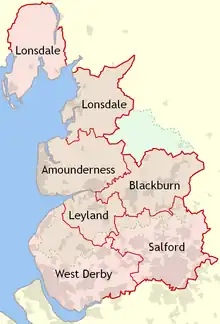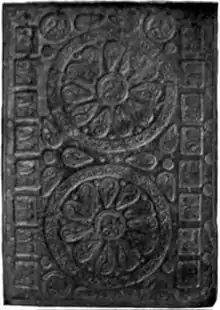Lancashire Domesday Book tenants-in-chief
The Domesday Book of 1086 AD identifies King William the Conqueror's tenants-in-chief for historic Lancashire within Cestrescire (Cheshire) and Eurvicscire (Yorkshire).[1] At the time of the Norman Conquest of England, the County of Cheshire included Inter Ripam et Mersam (between the River Ribble and River Mersey) which became South Lancashire (now including parts of Merseyside and Greater Manchester), while the West Riding (West Treding) of the County of Yorkshire included what became North Lancashire.[2]

Ancient hundreds of Lancashire

South Lancashire (Inter Ripam et Mersam) in the Domesday Book
Tenants-in-chief for lands in historic Cheshire:[3]
- Roger de Poitou was awarded over 50 lands including Blackburn, Crosby, Formby, Huyton, Kirkby, Knowsley, Leyland, Maghull, Manchester, Newton-le-Willows, Rochdale, Salford, Skelmersdale, Speke, Upholland, Warrington and West Derby. He was the son of Roger de Montgomery and he was one of William the Conqueror's main advisers. King Henry I confiscated all of his land between the River Ribble and the River Mersey, after Roger and his brothers' failed rebellion in 1102.[4]
Tenants-in-chief for lands in historic Yorkshire:[5]
- King William (c.1028–1087) held most lands that now form North Lancashire. He was the first Norman King of England (after the Battle of Hastings in 1066 AD) and he was Duke of Normandy from 1035.[6] His lands included: Aighton; Aldcliffe; Ashton-on-RIbble; Bare; Barton; Bispham; Bolton le Sands; Broughton; Carleton; Carnforth; Catterall; Chipping; Claughton; Clifton; Elswick; Eccleston; Fishwick (Preston); Forton; Freckleton; Garstang; Goosnargh; Greenhalgh; Grimsargh; Halton; Hambleton; Heaton; Heysham; Hutton; Inskip; Kirkham; Lancaster; Layton; Lea; Lytham; Marton (Blackpool); Middleton; Mythop; Nether Kellet; Newsham; Newton; Out Rawcliffe; Over Kellet; Overton; Oxcliffe; Plumpton; Poulton le Fylde; Preesall; Preston; Ribby; Ribchester; Rossall; Salwick; Singleton; Slyne; Staining; Stalmine; St Michael's on Wyre; Thornton; Thurnham; Torrisholme; Treales; Upper Rawcliffe; Warton; Weeton; Westby; Wheatley; Whittingham; Woodplumpton.

Cover of the Winchester Domesday Book of the 12th century
References
- "The Phillimore Translation - Hull Domesday Project". www.domesdaybook.net. Retrieved 5 May 2020.
- Frank Thorn and Caroline Thorn (2007). "Cheshire Notes". University of Hull's Hydra digital repository. Retrieved 10 May 2020.
- Powell-Smith, Anna. "Cheshire | Domesday Book". opendomesday.org. Retrieved 10 May 2020.
- Lee, S., ed. (1897). Dictionary of National Biography vol. 49. London: Smith, Elder & Co. p. 101.
- Powell-Smith, Anna. "Yorkshire | Domesday Book". opendomesday.org. Retrieved 23 November 2020.
- "William I 'The Conqueror' (r. 1066-1087)". The Royal Family. 2016. Retrieved 6 May 2020.
This article is issued from Wikipedia. The text is licensed under Creative Commons - Attribution - Sharealike. Additional terms may apply for the media files.